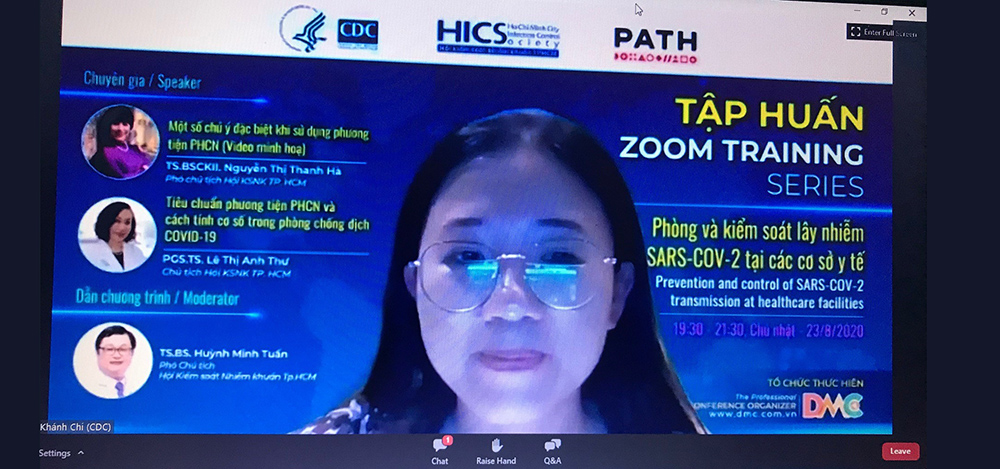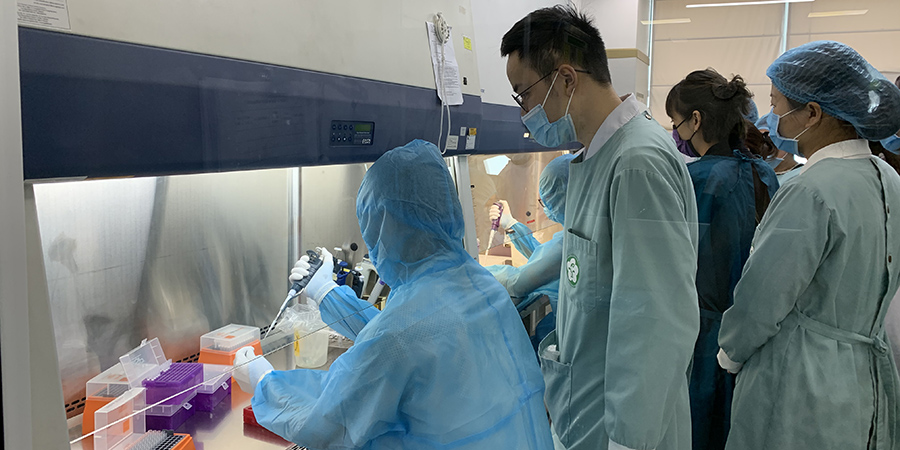CDC experts in Vietnam help local health officials take on COVID-19

CDC Vietnam’s Biosafety and Biosecurity Program Officer, Chi Bui, leads an online training session on SARS-CoV-2 infection prevention and control. Photo credit: Thuy Do.
As the world was waking up to the news about an unknown respiratory illness emerging in China in early 2020, Vietnam immediately took action to protect its nearly 98 million citizens. Experts say the early use of strict temperature screening and testing, targeted lockdowns, and constant communication to citizens helped the government control the pandemic.
Only days after the first reports that a new coronavirus was spreading in neighboring China, and two weeks before the first patient with COVID-19 was identified in Vietnam, the Ministry of Health (MOH) warned the population about this new threat.
With the help of a quick infusion of technical and financial support to the Vietnamese government from the U.S. Centers for Disease Control and Prevention (CDC), a multi-layered approach to fend off this virus was developed, limiting the spread of COVID-19 within its borders. CDC experts in Vietnam worked closely with partners, as COVID-19 was not the only disease outbreak the country faced in 2020.
Laboratory testing and biosafety go hand in hand
Even before the illness had a name, Thuy Thi Thu Do and Chi Bui, both members of the CDC Vietnam team, had been working closely with their counterparts at the health ministry, public health institutes throughout Vietnam, and other partners in an effort to limit the impact of the COVID-19 outbreak. Do leads CDC Vietnam’s team that helps laboratories improve operations for patient care and disease detection, and Bui helps labs maintain the best biosafety and biosecurity standards.
Do and Bui are part of a team of 68 CDC public health warriors dedicated to helping Vietnam expand ways to contain the COVID-19 pandemic while still addressing ongoing HIV, TB, and flu cases. The team helps Vietnam strengthen its ability to build laboratory and surveillance systems to better respond to disease outbreaks – old and new.
“In the beginning, we helped the MOH develop interim guidelines for SARS-CoV-2 testing,” says Do. “We also worked with the MOH to develop technical guidelines for biosecurity.”
“That’s because laboratory testing and biosafety go hand in hand,” Bui explains.
With so much unknown about the coronavirus, Do and Bui worked closely with colleagues at CDC headquarters in Atlanta to gather the latest information they could share with their partners in Vietnam. They also collected new information and guidelines generated by the WHO.
By keeping up with the latest data and understanding how and why guidelines changed, Do and Bui became valuable resources for their local counterparts at the MOH.
Do was added to an online chat group with 60 people ranging from the MOH to the provincial and laboratory levels. When Vietnamese media showed healthcare workers wearing personal protective equipment (PPE) like masks and gloves improperly or collecting samples incorrectly, Do would send messages and share current guidance.
“I think Do was on her phone 24 hours a day,” says Bui, “because people would send her questions any time there was a problem with a lab, a government official needed specific information, or there was anything COVID-19-related that needed to be resolved.”
To help inform public health workers about the quickly changing COVID-19 information, both Do and Bui conducted face-to-face training sessions early in the pandemic. These trainings were for healthcare workers within the preventive care services and clinical treatment systems, which are not always combined, but rather set up as a parallel structure in Vietnam.
Hundreds of healthcare workers attended CDC training on personal protective equipment
One area of concern was the proper use of PPE to reduce the likelihood of being infected with SARS-CoV-2 while conducting public health work.

CDC Vietnam’s Lab Program Officer Thuy Thi Thu Do, demonstrates how to safely put on and take off personal protective equipment (PPE) to properly protect themselves while testing patients who might have COVID-19. Photo credit: Chi Bui.
“Because healthcare workers are so scared of COVID-19, they wore too much PPE,” says Bui. Given the hot and humid conditions in Vietnam, too much PPE can make healthcare workers tired. “Sometimes they can’t work well because there are too many layers. If you wear two or three layers of gloves, for example, you can’t move your hands properly,” Do says.
In some cases, healthcare workers who were collecting samples or doing contact tracing would wear a hair cover, a head cover, a surgical mask, an N95 over the surgical mask, goggles, and a face shield.
Bui and Do recognized that people feared getting sick and therefore believed wearing as much PPE as they could was necessary. In response to these concerns, Do and Bui developed in-person training programs to help healthcare workers better understand how to protect themselves and still be able to do their job properly. Bui explained which and how much PPE to wear to prevent getting COVID-19. She used Do as her model. They also shared updates on testing methods, how to collect specimen, best ways to transport the specimen, verification processes for molecular diagnostic tests, and biosafety risk assessments.
“We invited laboratory experts, who work on a lot of SARS-CoV-2 testing in the biggest hospitals, to provide the training with us,” Do explains.
They also invited these experts to join them for training sessions outside the big cities, like in the Central Highlands region, for example.
When the second COVID-19 wave hit Vietnam in July 2020, Do and Bui were no longer able to provide in-person training. They switched to online training and collaborated with the Ho Chi Minh City Infection Control Society (HICS), for a series of 15 online training sessions on SARS-CoV-2 prevention and control. The response was overwhelming. Nearly 3,500 healthcare workers registered for these sessions. About 44% attended at least 5 sessions and about 20% participated in at least 10 sessions. In some cases, up to 800 people joined Do and Thuy in a training session at one time, including many who did not pre-register.
“It is something that we feel very proud of, because people really wanted information,” Bui says. “And even though it was two hours in the evening when they could be spending time with their family, they participated in the webinar to get updated information on COVID-19.”
After Do and Bui provided online training on specimen collection at Hanoi Medical University for staff from the Quality Control Center and the university’s hospital, the participants quickly turned the information into a training video that’s now on YouTube. “It even comes with English subtitles, so it’s now available to a much wider audience,” Do says.
Switching to saline solution saves money and makes more COVID-19 testing possible
When the pandemic began, interim guidelines for COVID-19 testing required that the swabs used to collect specimen from the nose or throat be preserved in a liquid called viral transport media (VTM).

Laboratory staff participate in wet lab practice for COVID-19 viral testing using real-time RT-PCR which is a part of a training workshop organized by Vietnam’s Ministry of Health with financial and technical support from CDC. Photo credit: Chi Bui.
The expansive global spread of COVID-19 meant demand for VTM worldwide was overwhelming. It was very difficult to buy it on the commercial market, and most laboratories didn’t have enough resources to make their own. This limited supply, coupled with huge demand for VTM, drove the cost of COVID-19 testing up dramatically.
Fortunately, the U.S. Food and Drug Administration (FDA), CDC, and WHO confirmed that saline solution can also safely preserve COVID-19 samples, so CDC Vietnam’s Global Health Security team quickly worked with the MOH to develop guidelines and detailed instructions for using saline solution as an alternative to VTM.
“This helped the MOH save a lot of money when they switched to using saline solution instead of the original media for storage.”
CDC support for Vietnam’s response also included advising laboratories on specimen collection; viral testing methods; interpretation of test results; and updating information about new virus variants and mutations for key staff and leaders at MOH departments, regional institutes, and key national hospital laboratories.
Prevention and control of another outbreak: diphtheria
Throughout the COVID-19 pandemic, other public health issues didn’t disappear. For example, Vietnam was facing a significant diphtheria outbreak in all four provinces of the Central Highlands in June 2020.
CDC’s Vietnam team provided technical assistance on surveillance and helped develop guidance for prevention and control of diphtheria, including the collection, packing, and transportation of specimen for testing. The CDC team also helped develop guidelines on specimens collection for a type of genetic test called RT-PCR testing, provided diphtheria testing materials, and helped Vietnamese partners build testing capacity.
The foundation for trust and collaboration leading to these accomplishments goes back 23 years, when the U.S. CDC began working with the Vietnamese government to build effective and reliable health systems throughout the country.
Bui and Do’s contributions, along with the contributions of the entire CDC Vietnam team, continue that tradition towards helping build a safer future.